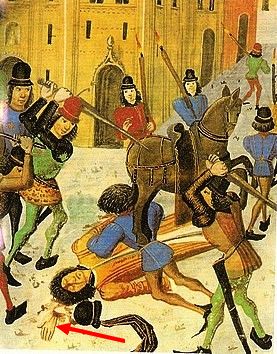 Centered around the brutal and shocking assassination of the Duke of Orleans, brother to the King of France.Returned home one night, he was set upon by a gang of mounted ruffians who bashed in his skull and left him for dead on the cobblestone street of Rue Vieille du Temple.
Centered around the brutal and shocking assassination of the Duke of Orleans, brother to the King of France.Returned home one night, he was set upon by a gang of mounted ruffians who bashed in his skull and left him for dead on the cobblestone street of Rue Vieille du Temple.
Jager’s retelling of the incident leads with an introduction of the Guillaume de Tigonville, “provost of Paris — the city’s chief of police. Knight, diplomat man of letters, and man of law, her was also very likely one of history’s first detectives”. Jager also gives the reader plenty of setting and background — even some illustrations — on medieval Paris, of France, and of European politics. He describes the complicated royal hierarchy and court system, tensions with England, and daily life in Paris.
Thankfully Jager doesn’t focus on the stench of medieval life as so many historians do. For sensory enhancement, Jager focuses on the dark. People were expected to be at home, with lights extinguished by a certain time. The city was still walled and officials would walk the streets to enforces the law. This meant Paris was dark — very dark. The Duke’s murderers used this to their advantage, banking on the idea that witnesses wouldn’t be able to identify anything specific. And in such enclosed dark, most would choose to remain safe behind barred doors, rather than venture our against an unseen enemy.
There was almost no street lighting in Paris after dark except for the occasional candle or lantern in a shop doorway. And because of the extreme danger to the flammable wooden houses in the tightly packed streets, all the lights and fires had to be covered and extinguished when the curfew bell rang at eight, plunging the city into darkness. Afterward, the night watch made its rounds, putting out any lights still burning and warning offenders.
The city was not only darker than usual on the moonless night but also very cold for that time of year. There are reports that it even began to snot. But no one knew that a great storm was on the way, the worst in at least a century, a storm that would plunge France into a long and deadly winter. ~Pg. 69

As provost of Paris, Guillaume was in charge of capturing the vagabonds as quickly as possible. What’s interesting in this case is G’s exceptional attention to detail. He took copious notes about the crime scene (somewhat disturbed before he arrived) and took dozens of witness statements, now matter how mundane the information seemed.
Guillaume was well acquainted with death in its many ugly forms from the battlefield, the gibbet, and the morgue, and his report is anatomically precise, even clinical. As a knight, he was familiar with various kinds of weapons and the terrible wounds they could inflict. Had he studied medicine as well? Or had he simply acquired a coroner’s observant eye during his six years as provost? Despite his experience though, he must have been shocked to see what the assassins had made of the duke with their swords and axes. ~Pg. 92
Jager has presented an atmospheric, historical mystery. That it’s a well-researched book about history is forgotten while reading about this pivotal incident.
Many thanks to Amelia at Little, Brown for the review copy.
__________________
Hardcover: 336 pages
Publisher: Little, Brown and Company (February 25, 2014)
Language: English
ISBN-10: 0316224510
ISBN-13: 978-0316224512
Product Dimensions: 9.4 x 6.3 x 1.1 inches
